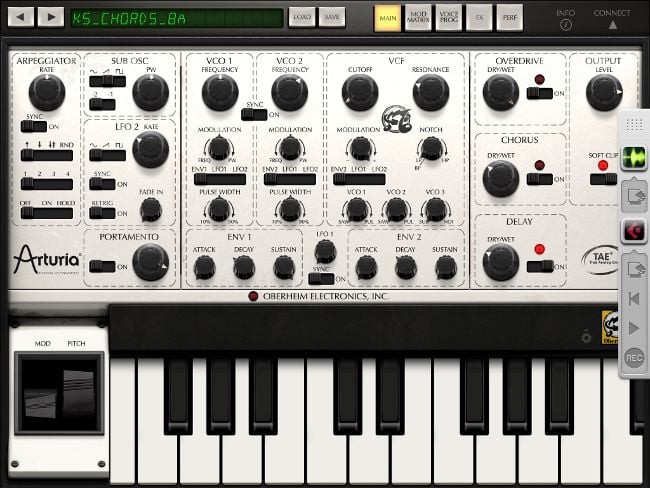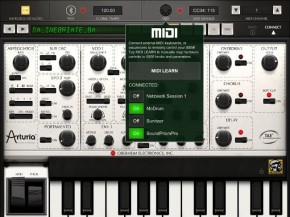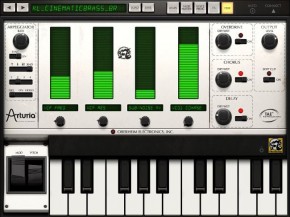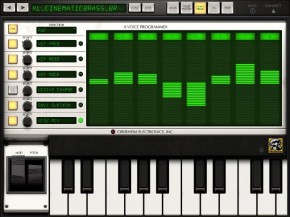Arturia iSEM
Hersteller: Arturia
Weitere Informationen:
http://www.arturia.com/evolution/en/products/iSem/intro.html
INFORMATION
iSEM is a recreation of the legendary 1974 Oberheim SEM synthesizer expander module. Known for its characteristic multimode filter and rich oscillators, the SEM module was revered for its sound by many.
Based on the TAE® technology found in our award winning SEM V software, iSEM faithfully recreates this unique synthesizer and offers a level of sound quality that only Arturia can bring to the iPad.
Main features:
iPad app recreating the classic Obeheim SEM synthesizer.
Hundreds of sounds created by some of the best sound designers around.
Audiobus support (to interact with other apps).
Core MIDI (to control your synth from a Hardware MIDI keyboard).
Apple’s Inter-app audio (to work in conjunction with GarageBand and other audio apps).
Preset transfer and sharing via email & iTunes file transfer.
Preset compatibility with the Arturia SEM V Mac/PC software.
WIST clock sync support (to synchronize two iPads).
Real analog sound based on our TAE® analog modeling.
Voice Programmer allows for recreating the rare and classic Oberheim Eight Voice.
Throughout the early 70’s, Tom Oberheim quickly gained a reputation as a talented effects manufacturer. His company Oberheim Electronics notably engineered the Maestro Ring Modulator and Phase Shifter which had a huge success in the US market.
After gaining experience as an official dealer for ARP Synthesizers in Los Angeles, he showed the Synthesizer Expander Module (SEM), that he designed with the help of Dave Rossum of E-mu Systems, in May 1974 at the Audio Engineering Society Convention in L.A.
The SEM was one of the world’s first self-contained synthesizer modules. It was primarily developed as a convenient solution for musicians who wanted to set up sequences without tying up their main synths. The SEM also worked very well as an expander to fatten up the tone of other synthesizers like the Minimoog™ or the ARP Odyssey. Soon the SEM gained a popularity of its own, thanks to the unique sounds generated by its innovative multimode Filter.
Upon this success, Tom expanded its concept by creating polyphonic synthesizers that were in effect combinations of the SEM with a digital keyboard in one carry-case. These 4 voice and 8 voice monsters were not only rare and expensive but had some of the best sound ever.
In 1985, Oberheim Electronics closed, however. Its brand is continued by the Gibson Guitar Corporation. But to the joy of synth enthusiasts, Tom recently restarted producing hand-made, updated SEMs and has announced the release of a successor to his original 4-voice.
iSEM tips its hat to the familiar interface of the classic 1974 Oberheim SEM, but there's more than meets the eye. We've added a few new features and some of the extra functionality that people have come to expect from Arturia products.
Taking a cue from the flexibility of modular synthesizers, we give you a handy way to create your own custom signal flow in the Modulation Matrix. Send 8 source signals to 25 destinations with bipolar control of each signal.
Inspired by the multi-timbrality of the Oberheim 2, 4 and 8 voice, the 8 Voice Programmer is a powerful module on which you can edit no less than 7 additional virtual SEM voices. The Voice Programmer makes programming a breeze thanks to its ergonomic interface. Whether you want to play spectral pads or complex sequences, this module will allow you to reach amazing sonic results in no time.
Effects mode brings a wide ranging, high quality chorus, analog delay and overdrive to further sculpt your sound.
The Performance mode gives you access to a multifunction arpeggiator and four assignable sliders, giving you real-time control over your sound. Our 8 Voice Programmer allows you to create per-voice parameter variations to create subtle analog anomalies to wild frequency freak-outs.
A rotating keyboard control panel allows you to set octaves, choose scales and other parameters. Set your key and choose from 26 scales, including Major, Minor, Pentatonic, Lydian and more. Use Zoom mode to customize the width of each key to fit your fingers and playing style. We've also included a Hold function for long ambient patches and dialing in your sound over an arpeggio.
iSEM is based on our award winning TAE® analog modeling technology; the same exact technology found in the parent software SEM V. It is not sample based and it is not based on the simple algorithms that others use to simulate analog sounds. It uses the same technology that drives all the Arturia software products to achieve strikingly realistic sound. It's this attention to detail that gives you a more true to life and natural analog synthesizer sound.
iSEM requires at least an iPad 2 and OS 6.0
Weitere Informationen: http://www.arturia.com/evolution/en/products/iSem/intro.html
Bewertungen




